Flaming Heart Cardigan |
|||||||||||||||||||
 |
 |
||||||||||||||||||
Knitted jacket in DROPS Brushed Alpaca Silk. The piece is worked bottom up with cables, double neck and split in sides. Sizes S - XXXL.
DROPS 245-9 |
|||||||||||||||||||
|
------------------------------------------------------- EXPLANATIONS FOR THE PATTERN: ------------------------------------------------------- GARTER STITCH (worked back and forth): Knit all rows. 1 ridge = knit 2 rows. PATTERN: See diagrams A.1 to A.2. The diagrams show all rows in the pattern from the right side. BUTTONHOLES: Work the buttonholes on the right band. 1 BUTTONHOLE = knit together the 3rd and 4th stitch from the edge and make 1 yarn over. On the next row knit the yarn over to leave a hole. Work the buttonholes when the piece measures S: 10, 18, 26, 34, 42 and 50 cm. M: 10, 18, 26, 34, 43 and 52 cm. L: 10, 18, 27, 36, 45 and 54 cm. XL: 10, 19, 28, 37, 46 and 55 cm. XXL: 10, 19, 28, 37, 47 and 57 cm. XXXL: 10, 19, 29, 39, 49 and 59 cm. DECREASE TIP (neck): All decreases are worked from the right side! DECREASE 1 STITCH AT BEGINNING OF ROW (right shoulder): Work 1 garter stitch, knit 1, slip 1 stitch knit-wise, knit 1 and pass the slipped stitch over the knitted stitch (1 stitch decreased). DECREASE 1 STITCH AT END OF ROW (left shoulder): Work until there are 4 stitches left, knit 2 together (1 stitch decreased), knit 1, 1 garter stitch. INCREASE TIP (sleeves): Start 1 stitch before the marker-thread, make 1 yarn over, knit 2 stitches (marker-thread is between these 2 stitches), make 1 yarn over. On next round, knit yarn overs twisted to avoid holes. Work then the new stitches in stocking stitch. ------------------------------------------------------- START THE PIECE HERE: ------------------------------------------------------- JACKET - SHORT OVERVIEW OF THE PIECE: The piece is worked in sections, back and forth with circular needle and bottom up, then sewn together. The sleeves are worked in the round with double pointed needles/short circular needle and bottom up. The neck is worked to finish. BACK PIECE: Cast on 136-142-150-158-182-194 stitches with circular needle size 4 mm and DROPS Brushed Alpaca Silk. Purl 1 row from the wrong side. Then work as follows from the right side: Sizes S and XXL: 1 edge stitch in GARTER STITCH – read description above, knit 1-2, work A.1A over the next 132-176 stitches, knit 1-2, 1 edge stitch in garter stitch. Sizes M, L, XL, XXXL: 1 edge stitch in GARTER STITCH – read description above, * knit 2, purl 2 *, work from *-* over the next 4-8-12-8 stitches, A.1A over the next 132-132-132-176 stitches, * purl 2, knit 2 *, work from *-* over the next 4-8-12-8 stitches, 1 edge stitch in garter stitch. Continue this rib (A.1A is repeated in height) for 10 cm, finish after a row from the right side. Work as follows from the wrong side: 1 edge stitch in garter stitch, purl 1-4-8-12-2-8, work A.1B over A.1A, purl 1-4-8-12-2-8 and 1 edge stitch in garter stitch = 124-130-138-146-166-178 stitches. Change to circular needle size 5 mm. Work next row as follows from the right side: 1 edge stitch in garter stitch, work 1-4-8-12-2-8 stocking stitches, A.2 over the next 120-120-120-120-160-160 stitches, 1-4-8-12-2-8 stocking stitches, 1 edge stitch in garter stitch. Continue this pattern. REMEMBER THE KNITTING TENSION! When the piece measures 39-40-41-42-43-44 cm, cast off 4-6-9-11-14-19 stitches for the armholes at the beginning of the next 2 rows = 116-118-120-124-138-140 stitches. Continue the pattern until the piece measures 56-58-60-62-64-66 cm. On the next row place the middle 32-34-36-38-40-42 stitches on a thread for the neck and finish each shoulder separately. Cast off 1 stitch on the next row from the neck = 41-41-41-42-48-48 shoulder stitches. The stitches which do not fit into the cable are knitted over knit and purled over purl. Cast off when the piece measures 58-60-62-64-66-68 cm. Work the other shoulder in the same way. RIGHT FRONT PIECE: Cast on 75-78-82-86-98-104 stitches with circular needle size 4 mm and DROPS Brushed Alpaca Silk. Purl 1 row from the wrong side. Then work as follows from the right side: Sizes S and XXL: 7 band stitches in garter stitch, work A.1A over the next 66-88 stitches, knit 1-2, 1 edge stitch in garter stitch. Sizes M, L, XL, XXXL: 7 band stitches in garter stitch, work A.1A over the next 66-66-66-88 stitches, * purl 2, knit 2 *, work from *-* over the next 4-8-12-8 stitches, 1 edge stitch in garter stitch. Continue this rib (A.1A is repeated in height) for 10 cm, finish after a row from the right side. Work next row as follows from the wrong side: 1 edge stitch in garter stitch, purl 1-4-8-12-2-8, work A.1B over A.1A, 7 band stitches in garter stitch = 69-72-76-80-90-96 stitches. Change to circular needle size 5 mm. Work next row as follows from the right side: 7 band stitches in garter stitch, A.2 over the next 60-60-60-60-80-80 stitches, work 1-4-8-12-2-8 stocking stitches, 1 edge stitch in garter stitch. On this row begin working the BUTTONHOLES – read description above. Continue this pattern. When the piece measures 39-40-41-42-43-44 cm, cast off 4-6-9-11-14-19 stitches for the armhole on the next row from the side = 65-66-67-69-76-77 stitches. When the piece measures 51-53-55-56-58-60 cm, place the outermost 20-21-22-23-24-25 stitches mid-front on a thread for the neck; to avoid cutting the strand work these stitches first. Now decrease as follows on each row from the neck: Decrease 1 stitch 4 times - read DECREASE TIP = 41-41-41-42-48-48 shoulder stitches. The stitches which do not fit into the cable are knitted over knit and purled over purl. Cast off when the piece measures 58-60-62-64-66-68 cm. LEFT FRONT PIECE: Cast on 75-78-82-86-98-104 stitches with circular needle size 4 mm and DROPS Brushed Alpaca Silk. Purl 1 row from the wrong side. Then work as follows from the right side: Sizes S and XXL: 1 edge stitch in garter stitch, knit 1-2, work A.1A over the next 66-88 stitches, 7 band stitches in garter stitch. Sizes M, L, XL, XXXL: 1 edge stitch in garter stitch, * knit 2, purl 2 *, work from *-* over the next 4-8-12-8 stitches, work A.1A over the next 66-66-66-88 stitches, 7 band stitches in garter stitch. Continue this rib (A.1A is repeated in height) for 10 cm. Finish after a row from the right side. Work next row as follows from the wrong side: 7 band stitches in garter stitch, purl 1-4-8-12-2-8, work A.1B over A.1A, purl 1-4-8-12-2-8 and 1 edge stitch in garter stitch. Change to circular needle size 5 mm. Work next row as follows from the right side: 1 edge stitch in garter stitch, 1-4-8-12-2-7 stocking stitches, work A.2 over the next 60-60-60-60-80-80 stitches, 7 band stitches in garter stitch. Continue this pattern onwards. When the piece measures 39-40-41-42-43-44 cm, cast off 4-6-9-11-14-19 stitches on the next row from the side = 65-66-67-69-76-77 stitches. When the piece measures 51-53-55-56-58-60 cm, place the outermost 20-21-22-23-24-25 stitches towards mid-front on a thread for the neck; to avoid cutting the strand work these stitches first. Now decrease as follows on each row from the neck: Decrease 1 stitch 4 times - read DECREASE TIP = 41-41-41-42-48-48 shoulder stitches. The stitches which do not fit into the cable are knitted over knit and purled over purl. Cast off when the piece measures 58-60-62-64-66-68 cm. SLEEVES: Cast on 60-60-64-64-68-68 stitches with double pointed needles/short circular needle size 4 mm and DROPS Brushed Alpaca Silk. Knit 1 round, then work rib (knit 2, purl 2) for 10 cm. Change to double pointed needles size 5 mm. Knit 1 round and decrease 12-10-12-10-12-10 stitches evenly spaced = 48-50-52-54-56-58 stitches. Insert 1 marker-thread at the beginning of the round = mid-under sleeve. Work stocking stitch in the round. When the sleeve measures 11-11-11-12-12-12 cm, increase 1 stitch on each side of the marker-thread – read INCREASE TIP. Increase like this every 4½-4-3½-3-2½-2 cm a total of 8-9-10-10-11-12 times = 64-68-72-74-78-82 stitches. When the sleeve measures 46-44-44-43-39-36 cm, work the sleeve cap back and forth (from the marker-thread) until the sleeve measures 48-48-49-49-47-47 cm (a 2-4-5-6-8-11 cm split at the top of the sleeve). Cast off. Work the other sleeve in the same way. ASSEMBLY: Sew the shoulder seams. Sew the sleeve cap to the armhole, then the split to the bottom of the armhole – see sketch. Sew the side seams in the outermost loop of the outermost stitch as far as the rib, leaving a split of 10 cm at the bottom. Sew the buttons onto the left band. DOUBLE NECK: Knit up from the right side 112 to 148 stitches round the neck (including the stitches on the threads), with short circular needle size 4 mm and DROPS Brushed Alpaca Silk. Stitch count should be divisible by 4. Work as follows from the wrong side: 7 band stitches in garter stitch, * purl 2, knit 2 *, work from *-* until there are 9 stitches left, purl 2 and 7 band stitches in garter stitch. Work this rib for 8 cm. Cast off 6 band stitches on each side and continue the rib with 1 garter stitch on each side. Work until the rib measures a total of 16 cm. Cast off. Fold the neck double to the inside and sew down, making sure the neck is not tight. |
|||||||||||||||||||
Diagram explanations |
|||||||||||||||||||
|
|||||||||||||||||||
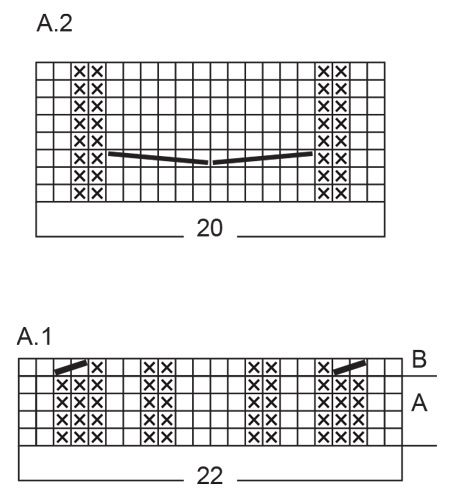
|
|||||||||||||||||||
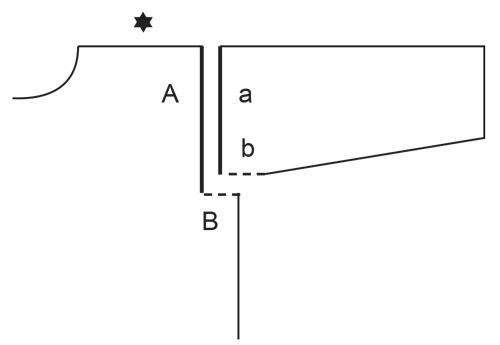
|
|||||||||||||||||||
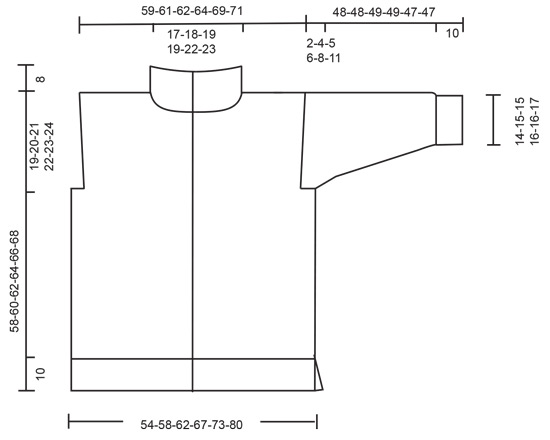
|
|||||||||||||||||||
|
Have you made this or any other of our designs? Tag your pictures in social media with #dropsdesign so we can see them! Do you need help with this pattern?You'll find tutorial videos, a Comments/Questions area and more by visiting the pattern on garnstudio.com. © 1982-2024 DROPS Design A/S. We reserve all rights. This document, including all its sub-sections, has copyrights. Read more about what you can do with our patterns at the bottom of each pattern on our site. |
|||||||||||||||||||







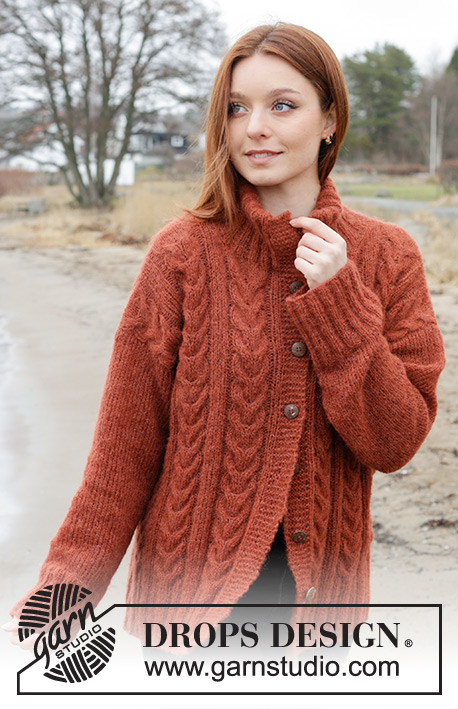
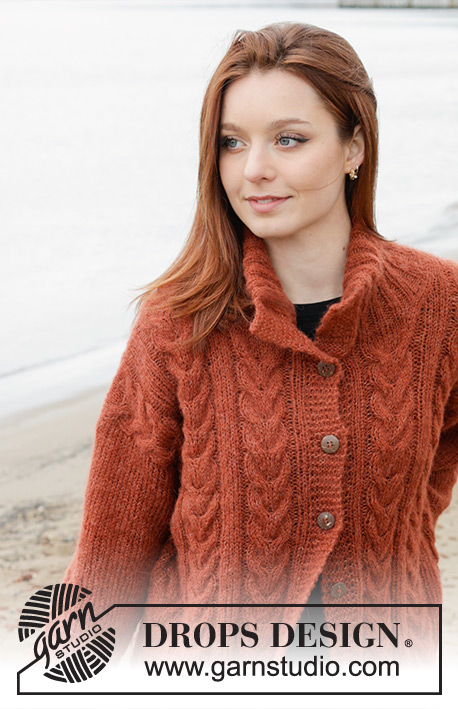
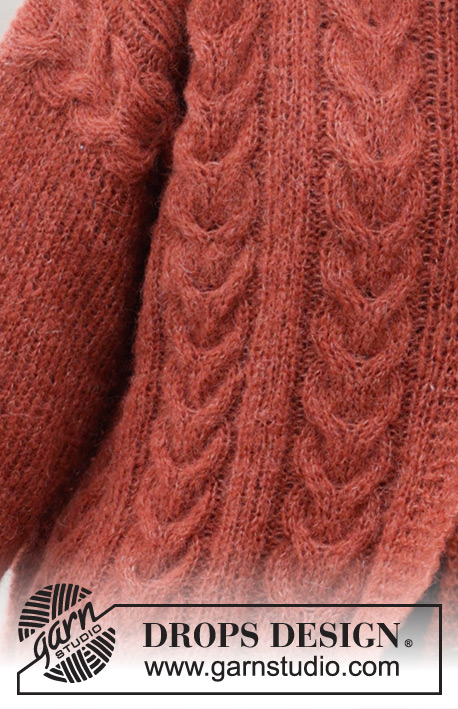


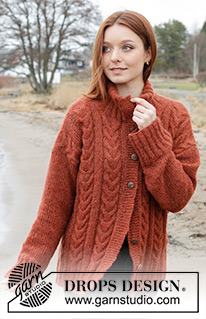
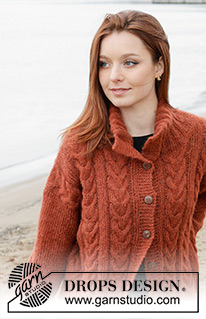
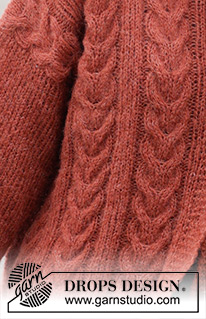































































Comments / Questions (6)
Hallo, wollte die Jacke Groesse M stricken und habe mir die angegebenen Wolle und Nadeln besorgt - bin jedoch kurz nach Beginn der Arbeit gescheitert. Bei Maschenprobe 17M = 10cm ergeben 130M (Rueckenteil) 76,5cm und nicht 58cm. Da auf dem Bild 10 Zopfreihen im Vorderteil abgebildet sind, ist die Anzahl der Maschen in der Strickanleitung scheinbar richtig -> das wuerde aber ca. 22M = 10cm ergeben, woraus eine Nadelstaerke von ca. 3 resultiert! Dies ist fuer die Wolle jedoch zu duenn...
12.03.2024 - 10:36DROPS Design answered:
Liebe Frau Gesche, die Maschenprobe wird glatt rechts gestrickt, man braucht aber mehr Maschen für Zöpfe als für glattrecht. So sollte Ihre Maschenprobe stimmen, dann haben Sie die richtigen Maßnahmen wie bei der Skizze. Viel Spaß beim Stricken!
12.03.2024 - 13:04Pumpkin Spice
07.08.2023 - 06:34Along with the sweater, it looks interesting, warm and cosy, and suit all sizes.
04.08.2023 - 06:52Wrap me up
04.08.2023 - 01:04Fox
03.08.2023 - 14:43Fox
03.08.2023 - 14:42